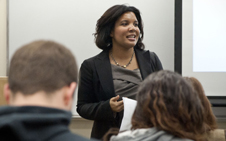3Qs: Gay rights and popular culture

Carole Bell, a postdoctoral teaching associate in communication studies in the College of Arts, Media and Design, conducts research on how the gay community in portrayed in popular culture. She wants to find out how the media’s framing of gay rights issues compares with society’s stance and how the media’s spotlight on homosexuality contributes to the public conversation on gay rights. We asked Bell to explain some of the factors that drive her research.
How has the entertainment industry’s representation of the gay community changed over the past few decades?
There have been significant changes in the portrayal of the gay community in television since the 1990s, when shows such as “Ellen” and “Will and Grace” first put gay characters at the center of mainstream television programs. Visibility is an important part of recognition and in terms of sheer numbers, gays are certainly more visible now than ever before. Watch the documentary “Further off the Straight and Narrow: New Gay Visibility on Television, 1998–2006” for more on this.
On the other hand, while the representation of gays and lesbians in popular culture has increased significantly in recent years, the substance and range of representation remains a source of some controversy.
What impact has reality TV had on the representation of the gay community in popular culture?
In an ironic twist, the proliferation of reality programs may have contributed to the ongoing stereotyping of gays, rather than diversified the range of representation. As media critic Jennifer Pozner has shown, reality shows employ a number of techniques to control the narrative and maximize dramatic tension. Storytelling relies heavily on stereotypical “characters” for their dramatic tension, and producers rely on casting, editing and cast manipulation to reproduce some of the broadest caricatures of gay life.
In contrast, scripted programs such as “Glee” and “Modern Family” are particularly notable and may even be historic for their portrayal of the gay community. Though not without their challenges, “Modern Family” is notable for its inclusion of a gay couple raising a child, while on “Glee,” critics and viewers have noted how gay teenage romance is portrayed in a way that has been on par with the portrayal of straight couples.
How closely is media representation correlated to public attitudes? Does media drive public opinion, or vice versa?
It’s hard to prove causation in terms of the effects of entertainment media, but we have seen significant changes in public opinion toward gay rights, particularly regarding same-sex marriage and gays serving in the military. It is well documented that these changes have coincided with changes in representation; media portrayals are an important part of our public discourse and contribute to the information environment in which opinions are formed about minority rights. Previous studies, for example, have shown a strong correlation between media usage and opinions on women’s rights.
While it’s fashionable to argue that the mainstream media do not reflect American values, a significant body of public opinion research, including that of Paul Brewer at the University of Wisconsin-Milwaukee, has shown that public policy preferences are closely aligned with core American values, including egalitarianism, individualism and libertarianism or belief in limited government. Further, Paul Kellstedt of Texas A&M found that these core values are reflected in the media’s framing of social issues.
To date, however, there is relatively little work examining potential connections between media framing and the support for policies protecting the rights of sexual minorities. As a result, whether media are driving change in public opinion toward gay rights is a particularly difficult question to answer given the limited available research in this area.




